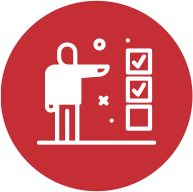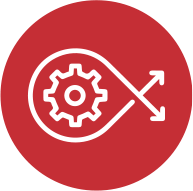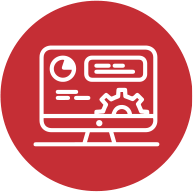What is RPA? (Robotic Process Automation)
RPA is a technology designed to automate repetitive, manual tasks. With RPA software, you can simulate the mouse and keyboard actions of employees within existing applications.
These so-called robot scripts can be scheduled to log in to a dedicated machine to perform tasks. For this reason, RPA is frequently positioned as software robots or virtual workers. This sometimes leads to a misconception that RPA involves physical robots. Despite this, it’s important to clarify that RPA doesn’t involve physical robots, even though both have their own account and machine to carry out tasks. This allows you to literally observe a virtual worker, seeing them execute various actions through the User Interface of applications.
In what contexts can Robotic Process Automation (RPA) be applied?
RPA can be used to automate tasks for all types of applications. Ranging from SAP and AFAS to Excel, its functionality can work with web applications as well as legacy systems. While it is capable of connecting with APIs when available, in cases where such interfaces are absent, RPA can automate tasks through the User Interface of applications. This inherent adaptability makes RPA widely applicable.
From financial processes and human resources management, to customer interactions. As well as across diverse sectors such as education, insurance, healthcare, and housing corporations. However, this versatility introduces a notable consideration – the comprehensive automation capability of RPA. The critical inquiry lies in whether RPA is always the optimal solution, taking into account both cost considerations and technical feasibility. Ideally, automation efforts prioritize leveraging existing application functionalities or refining processes through optimization and standardization.
This underscores that RPA is particularly suitable for automating processes that involve the utilization of multiple applications not directly amenable to integration.
The benefits of RPA
The Employee as an “Adhesive” Between ICT Systems?
For years, substantial investments have been made in new ICT systems: ERP, CRM, data warehouses, BI tools, customer portals. Yet, productivity does not seem to increase. Why is that?
We observe that employees often function as a sort of “adhesive” between ICT systems, working across multiple applications simultaneously to execute a single process. Our ICT landscapes have become (excessively) complex. The ICT department struggles to keep up with the pace of change within the organization. As for the employees, a significant portion of their time is spent transferring data from one system to another.
The Rise of RPA and the “last mile of automation”
Robotic Process Automation (RPA) can be perceived as a kind of “layer” on top of existing ICT applications. The RPA software utilizes existing applications to perform tasks and processes automatically. The robot can seamlessly execute a process that requires the involvement of up to five different applications. This enhances the level of automation and contributes to an increase in employee productivity.
As the robot essentially automates the final piece of work, leveraging existing automation, RPA is often referred to as the “last mile of automation.”
Our mission
We help both beginners and veterans with RPA
UiPath Gold implementation partner
UiPath stands as the global leader in RPA software, recognized by Gartner, Forrester, and other analyst firms for providing the best hyperautomation platform in the market.
As a UiPath Gold Partner, we understand that RPA is not a panacea and cannot be simply added on a whim. Successful implementation requires in-depth knowledge of the platform and its technology. We have wholeheartedly embraced the UiPath platform and invest every day in expanding our expertise and practical experience. Our aim is to be the premier independent partner to initiate or advance your RPA journey.






